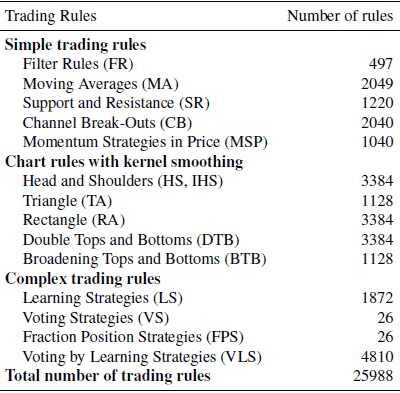Are “proven” technical trading rules reliable profit-makers, or artifacts of data snooping bias? In their April 2010 paper entitled “Illusory Profitability of Technical Analysis in Emerging Foreign Exchange Markets”, Pei Kuang, Michael Schröder and Qingwei Wang apply several tests to evaluate the decisiveness of data snooping bias in the past profitability of technical trading rules for ten emerging foreign exchange markets. These environments are arguably less intensively mined than many other financial markets. Using spot exchange rates in the selected markets over the period January 1994 to July 2007 to test 25,998 commonly used simple, pattern and complex trading rules (see the table below), they find that:
- Currency exchange rates for emerging markets have generally been more volatile than those for developed countries.
- Based on standard tests, there are hundreds to thousands of significantly profitable strategies. The best rules sometimes generate annual mean excess returns over 30%.
- There are no dominantly successful rules.
- Almost all these profits vanish after correction for data snooping bias.
- Findings are robust for two equal subperiods, three different levels of trading friction and various subsets of trading rules.
- When many researchers and practitioners repeatedly use the same new data to validate rules that excel in-sample, public reports of out-of-sample tests may incorporate data snooping bias.
The following table, taken from the paper, summarizes the types of rules tested in this study, segmented into three categories.

In summary, evidence from tests of an extensive set of technical trading rules as applied to emerging foreign exchange markets indicates that profitability of technical analysis, after correcting for data snooping bias, may be illusory.
A corollary is that the level of control required to distinguish confidently between luck and true anomaly may not be practicable in compute-intensive financial markets.